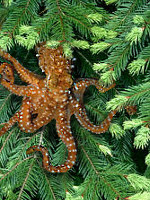Pacific Northwest tree octopus
| Pacific Northwest tree octopus | |
|---|---|
A tree octopus in the Pacific Northwest | |
| Scientific classification | |
| Kingdom | Animalia |
| Phylum | Mollusca |
| Class | Cephalopoda |
| Order | Octopoda |
| Genus | Octopus |
| Species | O. paxarbolis |
| Diversity | |
| Habitat | Arboreal, Pacific Northwest |
| Specifications | |
| Strength | Climbing, strangling |
| Intelligence | High |
| Length | 12-13" (30-33cm) |
| Conservation status | |
| Endangered | |
“Never did I sample a delicacy more flavorful than Rocky Mountain Oysters. But that Pacific Northwest tree octopus was pretty dandy, too.”
– Oscar Wilde on Pacific Northwest tree octopus
The Pacific Northwest tree octopus (Octopus paxarbolis) can be found in the temperate rainforests of the Olympic Peninsula on the west coast of North America. Their habitat lies on the eastern side of the Olympic mountain range, adjacent to Hood Canal. These solitary cephalopods reach an average size (measured from arm-tip to mantle-tip,) of 30–33 cm. Unlike most other cephalopods, tree octopuses are amphibious, spending only their early life and the period of their mating season in their ancestral aquatic environment. Because of the moistness of the rainforests and specialized skin adaptations, they are able to keep from becoming desiccated for prolonged periods of time, but usually prefer resting in pooled water.
Psychology
With the largest brain-to-body ration for any mollusc, the intelligent and inquisitive tree octopus explores its arboreal world by both touch and sight. Adaptations its ancestors originally evolved in the three-dimensional environment of the sea have been put to good use in the spatially complex maze of the coniferous Olympic rainforests. The challenges and richness of this environment (and the intimate way in which it interacts with it) may account for the tree octopus's advanced behavioral development.
Reaching out with one of its eight arms, each covered in sensitive suckers, a tree octopus might grab a branch to pull itself along in a form of locomotion called tentaculation; or she might be preparing to strike at an insect or small vertebrate, such as a frog or rodent, or to steal an egg from a bird's nest; or it might even be examining some object that caught its fancy, instinctively desiring to manipulate it with its dexterous sensory organs, in order to better know it.
Physiology
Tree octopuses have eyesight comparable to humans; besides allowing them to see their prey and environment, it is key in inter-octopus relations. Although they are not social animals, they display their emotions by changing the color of their skin: red indicates rage, and white, fear. While they normally maintain a mottled brown tone to blend in with the background, a small percentage (15% of the total "male" population) may turn to a light pink color when agitated.
The reproductive cycle of the tree octopus is still linked to its roots in the waters of Puget Sound, where it is thought to have originated. Every year, in the spring, tree octopuses leave their homes in the Olympic National Forest and migrate towards the shore and, eventually, their spawning grounds in Hood Canal. There, they congregate and find mates. After the male has deposited his sperm, he returns to the forests, leaving the female to find an aquatic lair in which to attach her strands of egg-clusters. The female will guard and care for her eggs until they hatch, refusing even to eat, and usually dying from her selflessness. The young will spend the first month or so floating through Hood Canal, Admiralty Inlet, and as far as North Puget Sound before eventually moving out of the water and beginning their adult lives.
Conservation status
Although the tree octopus is not officially listed on the U.S. Endangered Species List, many[citation needed] argue that it should be added, since its numbers are at a critically low level for its breeding needs, and it is under stress from decimation of its habitat by logging and suburban encroachment, roads that cut off access to the water which it depends on for spawning, predation by invasive or domestic species such as cats, and booming populations of its natural predators, including the bald eagle and sasquatch. The few that make it to the Canal are further hampered in their reproduction by the growing problem of pollution from farming and residential run-off. Unless immediate action is taken to protect the species and its habitat, the Pacific Northwest tree octopus may be but a memory[Pinko weenie].
Use as fashion accessories
The possibility of Pacific Northwest tree octopus extinction is not an unwarranted fear. Other tree octopus species—including the Douglas octopus and the red-ringed madrona sucker—were once abundant throughout the Cascadia region, but have since gone extinct because of threats similar to those faced by paxarbolis, as well as overharvesting by the now-illegal tree octopus trade.
The history of the tree octopus trade is a sad one. Their voracious appetite for bird plumes having exhausted all the worthy species of that family, the fashionistas moved on to cephalopodic accouterments during the early 20th century. Tree octopuses became prized by the fashion industry as ornamental decorations for hats, leading greedy trappers to wipe out whole populations to feed the vanity of the fashionable rich. While fortunately this practice has been outlawed, its effects still reverberate today as these millinery deprivations brought tree octopus numbers below the critical point where even minor environmental change could cause disaster.
Campaign to save the tree octopus
This article may contain a point of view. As you read this message, Uncyclopedia editors are hard at work at tracking down the point of view to its hiding place in the suburbs of Abbottabad. Please see the irrelevant discussion on the talk page. |
Here are a few things that you can do to help save the Pacific Northwest tree octopus.
- Write your representatives to let them know that you are concerned and that you feel the tree octopus should be included on the Endangered Species List and given special protection.
- Help build awareness of the tree octopus by telling your friends and co-workers.
- Place a tentacle ribbon on your website.
- Participate in tree octopus awareness marches. You can demonstrate their plight during the march by having your friends dress up as tree octopuses while you attack them in a lumberjack costume.
- Pamphlet your neighborhood. Tentacle ribbons make excellent doorknob hangers.
- Join and donate to an organization committed to conservation, such as Greenpeas.
- Boycott companies that use non-tree-octopus-safe wood harvesting practices.
- Sign the petition! Nothing activates activity like an Internet petition!
Organizations fighting to save the tree octopus
- Greenpeas.org - "Working to save the world from humans."
- The World Wildlife Fund: The WWF works to preserve genetic, species, and ecosystem diversity throughout the world, and also stages Wrestlemania events.
- People for the Ethical Treatment of Pumpkins - How many pumpkins must be sacrificed every year to decorate our houses and keep our bellies filled with pies before we realize the error of our ways? Too many, it seems!

